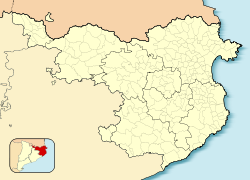Sant Joan de les Abadesses
Sant Joan de les Abadesses | |
|---|---|
 | |
 Map showing location within Ripollès | |
| Coordinates: 42°14′10″N 2°17′12″E / 42.23611°N 2.28667°E | |
| Country | |
| Community | |
| Province | Girona |
| Comarca | Ripollès |
| Government | |
| • Mayor | Ramon Roque Riu (2015)[1] |
| Area | |
| • Total | 53.7 km2 (20.7 sq mi) |
| Elevation | 773 m (2,536 ft) |
| Population (2018)[3] | |
| • Total | 3,224 |
| • Density | 60/km2 (160/sq mi) |
| Demonym(s) | Santjoaní, santjoanina |
| Postal code | 17860 |
| Website | santjoandelesabadesses |
Sant Joan de les Abadesses (Catalan pronunciation: [ˈsaɲ ʒuˈan də ləz əβəˈðɛsəs]) is a town and municipality located in the south-east of the comarca of Ripollès, in the province of Girona, Catalonia, Spain.
Geography and climate
The town is located along the upper part of the River Ter, in the valley of the same name, and enclosed by the Serra Cavallera mountain range to the north and the mountain of Sant Antoni to the south. It has an inland, continental climate, with abundant precipitation and notable temperature variability.
Economy
Most of the economy of Sant Joan de les Abadesses is centered on industry and manufacturing. However, there have more recently been increases in tourism to the town, with a corresponding increase in the service industry. Rural areas of the municipality are largely occupied by farms, usually raising cattle.
History
Ancient times
Human settlement in the valley around Sant Joan de les Abadesses dates to prehistoric times, and archeological research has found evidence of settlements in the region from the Lower Paleolithic era.[1]
It seems that the area was not very much Romanized, despite the fact that a branch of the
Middle Ages
The origins of the present town lie in the founding of the
This expulsion initiated a period of instability that lasted until the re-establishment of canons of the order of
Around the monastery, the town of Sant Joan was founded. Initially, the laypeople lived around the Church of Sant Pol, in the neighborhood today known as El Raval. But the town's growing population necessitated the construction of a walled town (the Vila Vella) on land that had been known as El Vinyal. This part of the town was home to numerous medieval guilds.
As time passed, power in the town shifted from religious to secular. The town became a
Contemporary era
In the mid-19th century, coal mining began in
During the
Main sights
- Monastery of Sant Joan de les Abadesses, founded in the late 9th century, with the current Romanesque complex built in the 12th century.
- Pont Vell, or "Old Bridge", built in the medieval era and in the Gothicstyle.
- Vila Vella, planned city built in the 13th century. It conserves its street layout, Main Square, and several houses from the 17th century.
- Remains of the Medieval walls, including two extant towers, and parts of the wall itself.
- "Way of Iron and Coal" (Ruta de Ferro i Carbó), a rail trail along the former railroad bed.
Twin towns
- Le Palais-sur-Vienne (France)
- San Luis Potosí (Mexico)
References
- Generalitat of Catalonia. Retrieved 2015-11-13.
- Statistical Institute of Catalonia. Retrieved 2015-11-23.
- ^ Municipal Register of Spain 2018. National Statistics Institute.
External links
- Town website
- Government data pages (in Catalan)


